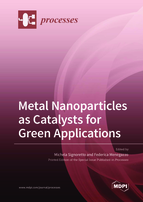Metal Nanoparticles as Catalysts for Green Applications
A special issue of Processes (ISSN 2227-9717). This special issue belongs to the section "Materials Processes".
Deadline for manuscript submissions: closed (31 March 2021) | Viewed by 23729
Special Issue Editors
Interests: nanostructured materials; heterogeneous catalysts; sustainable processes; mesoporous materials; green applications
Special Issues, Collections and Topics in MDPI journals
Interests: heterogeneous catalysis; metal nanoparticles; oxidation reactions; industrial processes; biomass valorization
Special Issues, Collections and Topics in MDPI journals
Special Issue Information
Dear Colleagues,
A strategic goal of our world is the development of a sustainable society, which is one that ‘meets the needs of the current generation without sacrificing the ability to meet the needs of future generations’. Catalysis, which represents probably the oldest application of nanotechnology, and green chemistry, have key roles on the road to sustainability.
This Special Issue collects original research papers or reviews focused on investigations on metal nanoparticles as catalysts for green applications. All applications which deals with designing chemical products and processes that generate and use less (or preferably no) hazardous substances, by applying the principles of green chemistry, are welcome for this special issue.
Topics include, but are not limited to:
-Development of homogeneous, heterogeneous, enzymatic catalysts for green applications
-Investigations on photocatalytic processes
-Innovative and sustainable syntheses of catalysts
-Hydrogenations, oxidations, isomerizations, hydrolysis reactions for biomass valorization
-New sustainable processes for the synthesis of important building blocks.
Prof. Dr. Michela Signoretto
Dr. Federica Menegazzo
Guest Editors
Manuscript Submission Information
Manuscripts should be submitted online at www.mdpi.com by registering and logging in to this website. Once you are registered, click here to go to the submission form. Manuscripts can be submitted until the deadline. All submissions that pass pre-check are peer-reviewed. Accepted papers will be published continuously in the journal (as soon as accepted) and will be listed together on the special issue website. Research articles, review articles as well as short communications are invited. For planned papers, a title and short abstract (about 100 words) can be sent to the Editorial Office for announcement on this website.
Submitted manuscripts should not have been published previously, nor be under consideration for publication elsewhere (except conference proceedings papers). All manuscripts are thoroughly refereed through a single-blind peer-review process. A guide for authors and other relevant information for submission of manuscripts is available on the Instructions for Authors page. Processes is an international peer-reviewed open access monthly journal published by MDPI.
Please visit the Instructions for Authors page before submitting a manuscript. The Article Processing Charge (APC) for publication in this open access journal is 2400 CHF (Swiss Francs). Submitted papers should be well formatted and use good English. Authors may use MDPI's English editing service prior to publication or during author revisions.
Keywords
- catalysts
- metal nanoparticles
- sustainable processes
- metal catalysts
- green applications
- green chemistry







